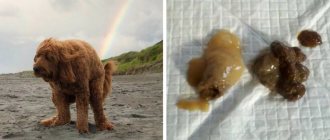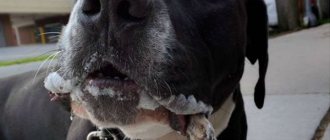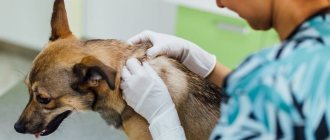Bloody diarrhea in a dog is a serious symptom that indicates problems in the digestive tract. If a dog has diarrhea with blood, this may be preceded by various reasons: poor nutrition, inappropriate standard of living, chronic diseases. Diarrhea with bloody discharge that does not stop for several days can become life-threatening for the animal. In this case, you must urgently seek help from a veterinarian.
The animal has bloody stool
Causes of loose, bloody stools in dogs
Bloody stool in a dog, why it appears:
- Internal injuries. If your pet's intestines are damaged, he will not be able to defecate normally. Injury can occur due to the consumption of certain foods (fish with bones that scratch the intestinal walls).
- Gastrointestinal diseases. Bloody feces appear in dogs due to dysbacteriosis and enteritis. You can tell that your pet is sick by looking at excrement with blood streaks and mucus. Another cause of bloody diarrhea is hemorrhagic gastroenteritis. This is a pathology that affects the intestines and stomach. In this case, the dog also experiences vomiting and a weak general condition. Bloody diarrhea can happen with hemorrhoids. In this case, the blood will have a scarlet tint. This disease is most often diagnosed in poodles, dachshunds, shelties, Spitz, and Yorkies.
- Oncological pathology. Bloody feces are one of the common signs of a progressive malignant process in the body. Similar symptoms are observed with tumor metastasis, but can also appear in the early stages of the disease.
Important! Loose stools with blood in a dog may indicate the presence of infections or parasites (tick bite) in the body, which could have entered it through poor-quality food.
Stool with blood from the anus
Veterinarians distinguish between two types of indigestion:
- spicy;
- chronic.
In acute cases, diarrhea lasts up to two days. If loose stools are not accompanied by elevated body temperature, vomiting, or convulsions, then in most cases it goes away on its own without any medical intervention on the part of the person.
The reasons for such diarrhea may be a change in the food given to the dog or the transfer of the animal from an industrial diet to a natural one.
Toilet shenanigans
If the diarrhea does not stop, then we are talking about a chronic indigestion, in which diarrhea drags on for two weeks or more. In this case, mucus and foam may come out with the stool, and traces of blood are often visible. Visually, bloody diarrhea in a dog is not necessarily red.
The stool may be black , which also indicates the presence of blood substances in it. In this case, the blood in the stool comes out already in a digested form, which means the problem must be looked for in the upper parts of the gastrointestinal tract. Red color of diarrhea indicates that the bleeding is in the large intestine.
In case of injuries, cuts, cracks and any other wounds of the rectum formed through mechanical force, the dog may also bleed from the anus. To exclude or, on the contrary, confirm this hypothesis, it is necessary to carefully examine the pet’s anus.
In puppies, bloody diarrhea indicates a terrible disease called parvovirus enteritis. It is accompanied by an increase in the animal's body temperature, vomiting, lethargy, and an extremely unpleasant smell of rot from the feces. The mortality rate of infected puppies is very high.
Diarrhea hides another unpleasant feature. The longer it lasts, the more the body dehydrates . Blood released during diarrhea and changes in the color of stool indicate serious problems with the dog’s health. Contacting a veterinary clinic will help you understand the causes of intestinal upset and promptly begin to take measures to save your four-legged friend.
What are the dangers of loose stool mixed with blood?
Inaction on the part of the owners when bloody excrement appears in a dog can cost the pets their lives. If negative symptoms appear as a result of internal bleeding, the animal may develop severe dehydration. The result is weight loss, deterioration in health, and death. The same thing happens with the progression of the infectious process in the body. If inflammation is not stopped in a timely manner, the situation can be fatal.
Sick dog
Briefly about the main thing
- Diarrhea, also known as diarrhea, is a symptom and not a separate disease.
- Chronic diarrhea is more dangerous because... may lead to death.
- If blood appears in the stool, contact your veterinarian immediately.
- Vomiting in symbiosis with diarrhea leads to severe dehydration; without timely assistance, the animal will die.
- The color of feces indicates pathological changes in organs.
- Treatment is carried out comprehensively, sometimes with a course of antibiotics.
- Nutrition during diarrhea is special, with plenty of water and a minimum amount of food.
First aid for diarrhea with blood and mucus in a dog
You can try to stop bloody diarrhea in a dog yourself at the initial stage. However, this does not eliminate the need for a full medical examination. The first thing the owner needs to do is stop the bleeding. To do this, you can turn to traditional medicine and use herbal decoctions (taken orally). If your pet is suffering from stomach problems, he needs to be given activated carbon or any other sorbent that will help remove toxins from the body.
Before going to the doctor, you should review your dog's diet. The diet should not contain solid foods, which can damage the walls of the stomach and cause even more bleeding. The basis of the menu should be low-fat meat broths. If the animal eats dry food, it must be softened in water before use.
Note! If there is acute pain, you should give your pet a painkiller and call a doctor at home.
During an exacerbation of the disease, it is necessary to ensure that your pet drinks plenty of fluids. It will help avoid dehydration. The water should be boiled and warm (room temperature). The dog must have 24/7 access to it. While your pet is waiting for medical attention, it is best to put him in a soft bed that will help him relax. The owners need to exclude any activity on the part of the dog.
Types of hematemesis in dogs
If you discover that a dog is vomiting blood, you should carefully consider this phenomenon and, if possible, determine the type of violation. This will allow you to provide the necessary first aid to your pet in a timely manner and inform the veterinarian to establish the correct diagnosis.
Bright scarlet blood indicates injury. This can be any mechanical damage to the esophagus, oral cavity or pharynx. In this case, you should immediately examine the dog: check the gums, pay attention to the occurrence of tumors and wounds. Particular attention should be paid to the tongue and the cavity under it. Sometimes a thread loop may be found extending from the gastrointestinal tract - evidence of intestinal obstruction.
If your dog is vomiting brown blood, this is a dangerous symptom. He's talking about internal bleeding in the stomach. Under the influence of hydrochloric acid, the blood mass becomes brown and thicker.
Dark color of vomit is a clear sign of kidney failure, poisoning, parvovirus enteritis. Associated signs of kidney failure may include diarrhea and anemia. They also include the appearance of a slight ammonia odor from the dog’s mouth against the background of vomiting.
Proper nutrition during diarrhea
If a dog is vomiting blood, you need to take care of its proper nutrition. In the first 2-3 weeks after the onset of negative symptoms, you will need to adhere to a special therapeutic diet. It should be based on liquid and soft food with a minimum amount of fats and dyes. However, you should not completely give up products. The animal needs vitamins, minerals, macroelements for the full development of the body and a speedy recovery.
When the condition normalizes a little, you can introduce fermented milk products (low-fat or low fat) into the menu. At this stage, it is allowed to give dogs boiled rice porridge, boiled meat and vegetables (finely chopped). You'll have to wait a bit with the dog bones. All food should be steamed. The amount of salt should be kept to a minimum. Spices should be completely excluded.
Feeding a sick pet
Important! If owners do not have time to cook at home, you can feed your pet with special medicinal foods that help normalize the functioning of the gastrointestinal tract.
What determines the color of diarrhea?
The color of feces can vary significantly from light yellow to black. This depends on many factors - the presence of blood, pigments, food eaten, medications, the condition of organs and much more. Let us analyze and describe each type (color) of feces and its probable causes of occurrence.
Yellow
Appears with indigestion, liver diseases, blockage of the bile ducts, hepatic jaundice and more, the main reason is the rapid movement of bile pigment - bilirubin through the intestines, which does not have time to transform into the usual brown color.
Orange
Indicates diseases of the gallbladder, biliary tract and liver.
Black
Appears when there is bleeding in the stomach or small intestine, as well as when feeding activated charcoal to an animal.
Green
Indicates rotting of the intestinal contents (with subsequent absorption of rotting products into the blood), dysbiosis, viral and bacterial infections, and the dog eating green plants and vegetables.
Red
Caused by bleeding or damage to the wall of the large intestine or severe inflammation in it.
Dark brown
Normally, feces have different shades of brown, they depend on the food that is given to the animal.
Grey
Signals the presence of parasites in the body, also found in parvovirus enteritis.
White
Indicates complete blockage of the biliary tract.
Green vomit with diarrhea
Indicates intestinal obstruction as bile and intestinal contents enter the stomach.
How is the diagnosis carried out?
Before treating your dog, you need to understand the diagnoses. To find out the cause of bloody diarrhea in a dog, you will need a full examination by a veterinarian. Modern clinics have appropriate equipment that helps with making a diagnosis and determining treatment tactics. First of all, the doctor will conduct an examination and interview the owner about the symptoms that were bothering the dog. The following diagnostic measures will be prescribed:
- analysis of blood, urine, feces to determine the inflammatory process, parasites or infections;
- Ultrasound of the abdominal organs, which will help determine the presence of tumors;
- X-rays, endoscopy - procedures that will help assess the condition of the gastric mucosa.
Based on the results of the examination, the veterinarian will prescribe treatment. It can be medicinal or surgical (in advanced cases). If the cause of the disease is not dangerous to health, then the doctor can only prescribe a special diet and recommendations for caring for the animal.
What to do?
If you notice your dog has diarrhea with blood, you should immediately take him to the veterinary clinic. During training and on the road itself, it would be useful to conduct a mental analysis and remember what factors and changes in the dog’s life could provoke the disease. Did blood appear in the stool after switching your pet to a new food?
During a walk, did the dog pick up scattered pieces of any food or chew sharp sticks, swallowing splinters from them? When was the last time you were dewormed? All this information will help the veterinarian quickly and accurately understand the problem.
Feed
After a visual examination, a clinical blood test and a general stool test are prescribed. By assessing the hemoglobin level, the amount of blood loss is determined. If helminths are found in the stool, then the possible cause of the disease is helminthiasis.
An x-ray is taken to check the stomach and intestines. It helps to identify the presence of sharp foreign objects in organs and perforation of the walls of the latter. In order to clarify the diagnosis, specialists can prescribe a biochemical blood test, ultrasound of the abdominal cavity, gastroscopy, colonoscopy.
Once a diagnosis is made, the optimal course of treatment is developed.
- For infectious causes of blood in the stool, the patient is prescribed immunomodulators and antibiotics.
- In case of food poisoning, the dog's stomach is washed and then probiotics and sorbents are prescribed to normalize the digestion process.
- In cases of allergic reactions, diarrhea with blood is treated with medications and urgent removal of the allergen from the diet.
If diarrhea lasts a week or more, the animal is given a drip to restore the water-salt balance. For large blood losses, medications that improve blood clotting are prescribed.
Surgical intervention becomes relevant in cases of foreign body entry into the dog’s gastrointestinal tract, as well as when neoplasms are detected.
Once your dog develops bloody diarrhea, it is very important to stop giving him any food for the day and then make sure he drinks as much water as possible. This reduces the risk of dehydration. The fasting time for a puppy should be 6 hours, for an adult dog - up to 24 hours.
Treatment of bloody diarrhea in puppies with parvovirus enteritis is a very troublesome and time-consuming task. During treatment, the dog is deprived of food and, in some cases, water. The diet can last from 3 to 10 days. They are prescribed IVs with saline solution, glucose, vitamins and microelements.
Puppies
In addition to intravenous infusions, animals are prescribed immunoglobulin serums. Veterinarians also prescribe antibiotics to help fight bacteria in the intestines. After the course of medication, it is necessary to give the puppy medications containing bifidobacteria and lactobacilli to restore the stomach microflora.
Every dog owner needs to be aware that the recovery of his pet depends entirely on his correct actions in the first stages of the disease, subsequent implementation of the doctor’s recommendations, compliance with the prescribed course of treatment and care for the animal.
When to urgently contact a veterinarian
If blood discharge from the anus is an isolated phenomenon, then you can try to solve the problem yourself by adjusting your diet. Bloody diarrhea may have occurred as a result of eating expired or poorly washed food. If your dog systematically develops blood clots and bile in the dog’s feces, and his general condition worsens, you should visit a veterinarian, as the pet’s life may be in danger. Symptoms that indicate an immediate need for medical attention:
- the dog begins to vomit and loses its appetite;
- the animal loses weight and becomes less active;
- the pet whines and practically does not sleep;
- the amount of blood in the stool increases each time;
- Along with vomiting, the dog develops foam and yellow discharge.
Another dangerous sign is a change in the smell of stool, as well as its color and structure.
Sick pet
Symptoms
Symptoms for different causes will also differ. To do this, you need to carefully remember all the details from the dog’s life over the past few days. If she has:
- loose stools of any color;
- blood or bleeding;
- elevated temperature;
- discharge from the eyes and nose;
- apathy;
- vomit;
- refusal of food;
If there is an intestinal disorder from poor quality nutrition, the dog's stool will be light, sparse and without a strong odor. The general condition of the animal is satisfactory.
When affected by distemper, a viral infection, the stool will be dark green in color with an elevated temperature in dogs, raised to critical points. Infectious enteritis causes diarrhea that is gray to orange in color, foul-smelling, and streaked with blood.
Worm infestations can manifest as vomiting and diarrhea, but at a normal temperature in the dog. Such violations do not occur rarely.











